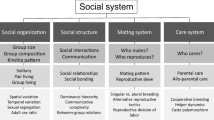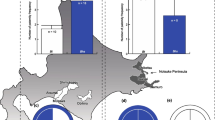Abstract
The Stenogastrinae are a subfamily of the Vespidae. The main difference between these and other social wasps (Polistinae and Vespinae) is a jelly-like substance that the Stenogastrinae secrete from the Dufour 's gland and use in many functions of their biology. It is suggested that this substance greatly contributed to the evolution of social life in these wasps by making it possible to nourish the brood with liquid food and store it in the nest, thus favoring also the evolution of the behavioral mechanisms which facilitated interactions between adults. Social organization of the colonies may have been kept at a low level through a basic system of continuous temporary helper replacement, while the evolution of large colonies was restrained, as well as by the poor quality of construction material, low egg-laying capacity and limited production of abdominal substance, imperfect social regulatory mechanisms, and the absence of defensive mechanisms of the colonies against large predators.
Similar content being viewed by others
References
Akre, R. D. (1982). Social Wasps. In Hermann, H. R. (ed.),Social Insects, Academic Press, New York, pp. 1–105.
Brockmann, H. J. (1984). The evolution of social behavior in Insects. In Krebbs, I. B., and Davies, N. B. (ed.),Behavioural Ecology: An Evolutionary Approach, Blackwell, Oxford, pp. 340–361.
Carpenter, J. M. (1981). The phylogenetic relationships and natural classification of the Vespoidea (Hymenoptera).Syst. Entomol. 7: 11–38.
Carpenter, J. M. (1988). The phylogenetic system of the Stenogastrinae (Hymenoptera: Vespidae).J. N.Y. Entomol. Soc. 96: 140–175.
Hansell, M. H. (1981). Nest construction in the subsocial waspParischnogaster mellyi (Saussure) (Stenogastrinae, Hymenoptera).Insectes Soc. 28: 208–216.
Hansell, M. H. (1986). Colony biology of the stenogastrine waspHolischnogaster gracilipes (Van der Vecht) on Mount Kinabalu.Entomol. Mon. Mag. 122: 185–188.
Hansell, M. H. (1987a). Nest building as a facilitating and limiting factor in the evolution of eusociality in the Hymenoptera.Oxford Surv. Evol. Biol. 4: 155–181.
Hansell, M. H. (1987b). Elements of eusociality in colonies ofEustenogaster calyptodoma (Sakagami & Yoshikawa) (Stenogastrinae, Vespidae).Anim. Behav. 35: 131–141.
Hansell, M. H., Samuel C., and Furtado, J. I. (1982).Liostenogaster flavolineata: social life in the small colonies of an Asian tropical wasp. In Breed, M., Michener, C. D., and Evans, H. E. (eds.),The Biology of Social Insects, Westview Press, Boulder Colo., pp. 192–195.
Hunt, J. H., Baker, I., and Baker, H. G. (1982). Similarity of amino acids in nectar and larva saliva: The nutritional basis for trophallaxis in social wasps.Evolution 38: 1318–1322.
Ito, Y. (1986). Social behavior ofRopalidia fasciata (Hymenoptera: Vespidae) females on satellite nests and on a nest with multiple combs.J. Ethol. 4: 73–80.
Jeanne, R. L. (1975). The adaptiveness of social wasp nest architecture.Q. Rev. Biol. 50: 267–287.
Jeanne, R. L. (1979). Construction and utilization of multiple combs inPolistes canadensis in relation to the biology of a predaceous moth.Behav. Ecol. Sociobiol. 4: 293–310.
Krombein, K. V. (1978). Biosystematic studies of Ceylonese wasps. III. Life history, nest and associates ofParaleptomenes mephitis (Cameron) (Hymenoptera: Eumenidae).J. Kans. Ento-mol. Soc. 51: 721–734.
Malishev, S. I. (1968).Genesis of the Hymenoptera and Phases of their Evolution, Methuen, London.
Michener, C. D. (1985). From solitary to eusocial: Need there be a series of intervening species? In Holldobler, B., and Lindauer, M. (eds.),Experimental Behavioural Ecology and Sociobiology, Sinauer Associates, Sunderland, Mass., pp. 293–305.
Montagner, H. (1971). Les communications interindividuelles dans les societes de Guepes.J. Psychol. Norm. pathol. 3–4: 281–296.
Ohgushi, R., Sakagami, S. F., Yamane, S., and Abbas, N. D. (1983). Nest architecture and related notes of Stenogastrine wasps in the Province of Sumatera Barat, Indonesia (Hymenoptera, Vespidae).Sci. Rep. Kanazawa Univ. 28: 27–58.
Pardi, L. (1948). Beobachtungen uber das interindividuelle verhalten beiPolistes gallicus. (Untersuchungen uber die Polistini, N. 10).Behaviour 1: 138–172.
Richards, O. W. (1962).A revisional study of the masarid wasps (Hymenoptera: Vespoidea), British Museum (Natural History), London.
Roubaud, E. (1916). Recherches biologiques sur les guepes solitaires et sociales d'Afrique.Ann. Sci. Nat. Zool. 101: 1–160.
Samuel, C., and Hansell, M. H. (1987). Fully social life in the small coloniesof Liostenogaster flavolineata (Cameron) (Stenogastrinae, Vespidae). Abstr. 20th Int. Ethol. Congr., Madison, p. 156.
Spradbery, J. P. (1973).Wasps, Sidgwick & Jackson, London.
Spradbery, J. P. (1975). The biology ofStenogaster concinna Van der Vecht with comments on the Phylogeny of the Stenogastrinae (Hymenoptera Vespidae).J. Austr. Entomol. Soc. 14: 309–318.
Strassmann, J. (1981). Evolutionary implications of early male and satellite nest production inPolistes exclamans colony cycles.Behav. Ecol. Sociobiol. 8: 55–64.
Turillazzi, S. (1985a). Brood rearing behaviour and larval development in Parischnogaster nigricans serrei (Du Buysson) (Hymenoptera Stenogastrinae).Insectes Soc. 32: 117–127.
Turillazzi, S. (1985b). Function and characteristics of the abdominal substance secreted by wasps of the genusParischnogaster (Hymenoptera Stenogastrinae).Monitor Zool. Ital. (N.S.) 19: 91–99.
Turillazzi, S. (1985c). Colonial cycle inParischnogaster nigricans serrei (Du Buysson) in West Java (Hymenoptera Stenogastrinae).Insectes Soc. 32: 43–60.
Turillazzi, S. (1986a). Les Stenogastrinae: Un groupe clé pour l'etude de l'evolution du comportement social chez les guêpes.Actes Coll. Insectes Soc. 3: 7–32.
Turillazzi, S. (1986b). Colony composition and social behaviour ofParischnogaster alternata Sakagami (Hymenoptera, Stenogastrinae).Monitore Zool. Ital. (N.S.) 20: 333–347.
Turillazzi, S. (1987). Distinguishing features of the social behaviour of Stenogastrinae wasps. In Eder, J., and Rembold, H., (eds.),Chemistry and Biology of Social Insects, Verlag Peperny, Munchen, pp. 492–495.
Turillazzi, S. (1988). Social biology ofParischnogaster jacobsoni (Du Buysson) Hymenoptera Stenogastrinae).Insectes Soc.,35: 133–143.
Van der Vecht, J. (1977). Studies of oriental Stenogastrinae (Hymenoptera: Vespoidea).Tijschrifi Entomol. 120: 55–75.
West Eberhard, M. J. (1978). Polygyny and the evolution of social behavior in wasps.J. Kans. Entomol. Soc. 51: 832–856.
West Eberhard, M. J. (1987). The epigenetical origins of insect sociality. In Eder, J., and Rembold, H. (eds.),Chemistry and Biology of Social Insects, Verlag Peperny, Munchen, pp. 369–371.
Wilson, E. O. (1971).The Insects Societies, Harvard University Press, Cambridge, Mass.
Yamane, S., Sakagami, S. F., and Ohgushi, R. (1983). Multiple behavioural options in a primitively social wasp,Parischnogaster mellyi. Insectes Soc.30: 412–415.
Yoshikawa, K., Ohgushi, R., and Sakagami, S. F. (1969). Preliminary report on entomology of the Osaka City University 5th Expedition to Southeast Asia, 1966.Nat. Life S.E. Asia Tokyo VI: 153–182.
Author information
Authors and Affiliations
Rights and permissions
About this article
Cite this article
Turillazzi, S. The origin and evolution of social life in the Stenogastrinae (Hymenoptera, Vespidae). J Insect Behav 2, 649–661 (1989). https://doi.org/10.1007/BF01065784
Accepted:
Issue Date:
DOI: https://doi.org/10.1007/BF01065784




